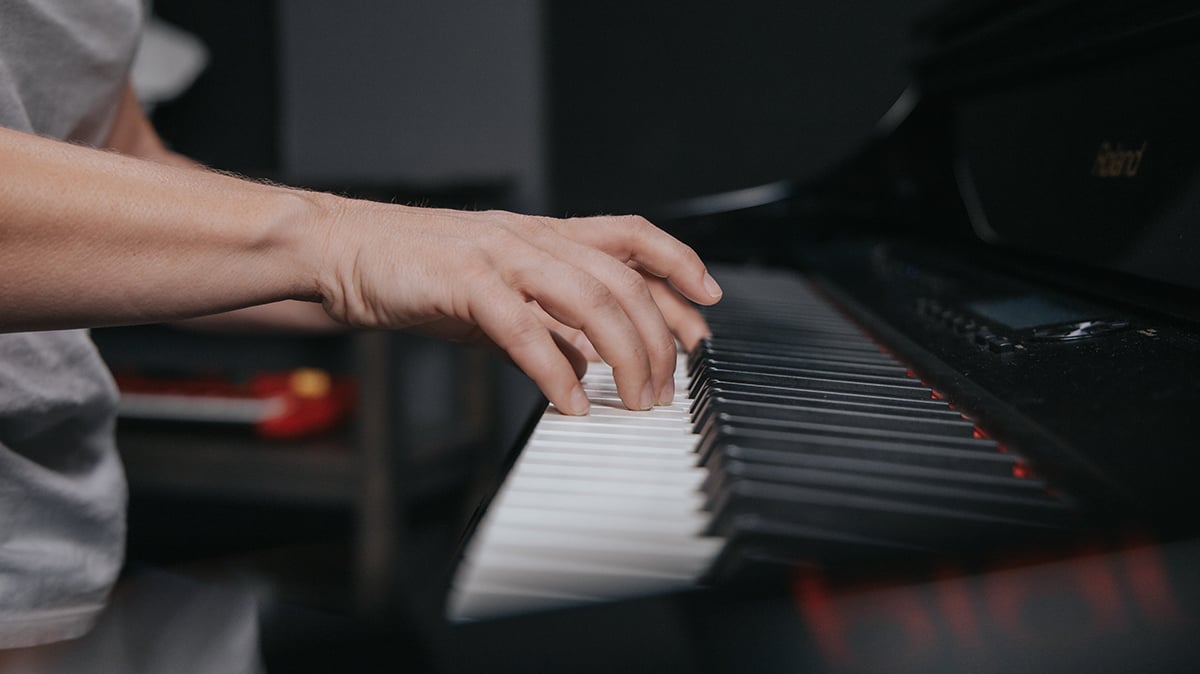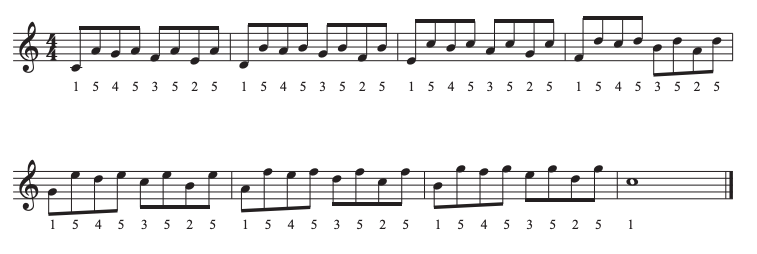I’m going to show you a super-quick exercise to help you play piano faster…
In just 5 minutes.
Now, it will take longer than 5 minutes to see the best results. But you can do this exercise in 5 minutes or less. And by doing it regularly…
You’ll get super-speedy fingers in no time!
Let’s get started!
To build speed we’ll be using Hanon No.6. It’s one of my favorite exercises.
If you haven’t seen this one before, spend some time learning the basic pattern and fingering.

Now, the focus will not be on the exercise itself, but those little adjustments to your hands and fingers that you can make to play piano faster.
Because it’s those little physical changes that end up making the most difference to your skill level over time.

Everyone wants to play fast.
Being a speed demon on the piano dazzles and impresses. And it’s really fun! But while playing fast can look difficult, it’s absolutely doable if you know the right techniques and exercises. Introducing: Faster Fingers, a 30-lesson course pack to get you there. Free with your Pianote membership!
The key to developing speed with this exercise is in your wrist.
What I mean by that is using slight rotations in your wrist to help get your fingers into position faster and more smoothly.
This allows my fingers to just press straight down. I’m not thinking of “muscling” each of my fingers individually.
That’s only going to slow me down.
The rotation in the wrist shouldn’t be excessive. But slight enough to move your fingers into the correct position:
The other big thing to remember is…
Start SLOW.
I know I say this a lot, but that’s only because it’s so important. If this is new to you it will feel a little odd to use your wrist like that.
So go slow, and make sure you’re comfortable. I recommend starting at a tempo between 60 and 80bpm.
Another crucial way to increase your speed on the piano is to use your brain.
You want to be thinking ahead as you’re playing, so you can set yourself up for success.
Here’s what I mean.
As you play this exercise, it will be super important to be in the correct position at the start and the end of each pattern.
To do that, you want to be thinking about the top and bottom notes. Because if you get those correct, the rest will come naturally.
Let’s look at the opening measure.

As you play, notice that your thumb can gently slide up from that first C note to the D.
And that D is your next starting note. You’re already in position for the next pattern.
I know I said it before, but it’s worth repeating…
START SLOW (See I even yelled it there).
Going too fast too soon is a recipe for bad habits, frustration, and ultimately failure.
To play piano faster with excellence means being able to keep a steady beat. So you’ll want to use a metronome as you begin.
The metronome is also a great way to track your progress. It’s super encouraging to be able to SEE the difference in speed from day to day and week to week.
You could even write it down in your practice journal as a source of motivation and to see how far you’ve come!
You should absolutely practice this with your left-hand as well. And we’ve included the left-hand fingering patterns on the sheet music.

But here’s what you need to know…
It’s completely normal to be slower in your left-hand than your right. People get so frustrated here because they think:
“I can play at this bpm in my right-hand but my left-hand’s slower.”
That’s normal.
Our left-hand is often the weaker hand because it doesn’t do all the crazy melody playing that the right-hand does.
So be kind to yourself. Drop the tempo down a little bit.
This practice should take no longer than 5 minutes.
But it’s something you should strive to include in your regular practice routine. Try it for a week, write down your starting tempo and see what progress you can make!
I hope you enjoyed this tip on how to play piano faster and good luck!
If you really want to see serious speed results, we have an entire training pack designed to do just that.
It’s called Faster Fingers, and it’s a detailed, guided lesson path to help you build speed and play with more control.
Have fun!
Lisa Witt has been teaching piano for more than 20 years and in that time has helped hundreds of students learn to play the songs they love. Lisa received classical piano training through the Royal Conservatory of Music, but she has since embraced popular music and playing by ear in order to accompany herself and others. Learn more about Lisa.


By signing up you’ll also receive our ongoing free lessons and special offers. Don’t worry, we value your privacy and you can unsubscribe at any time.
We use cookies for traffic data and advertising. Cookie Policy »